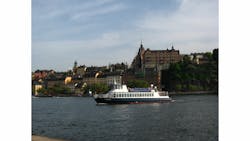Stockholm’s Supercharged Electric Ferry Set to Make Waves
In Sweden’s capital city, Stockholm, built across some 14 islands, ferries provide a crucial means of public transport. In August, this year, one of them, the world’s first super-charged, will in the space of just 10 minutes create the first zero-emission waves in public transportation.
Back in 2012, the Swedish Energy Agency, Energimyndigheten, as part of its demonstration of electrically powered vehicles program, awarded a grant to Stockholm’s Echandia Marine. The idea was to reduce the detrimental effects on the environment caused by ferries, such as high carbon dioxide, nitrous oxide and particulate matter emissions. Now in 2014, the energy agency’s vision takes shape in the name of the E/S Movitz prototype, a 75-foot ferry, retrofitted with two 125 kV electric motors that will propel it and the rest of maritime transportation into a zero-emissions reality.
Sweden is often heralded for having an exemplary energy and climate policy due to the 2008/09:162 and 2008/09:163 legislation. This legislation set ambitious 2020 energy-related targets back in 2009, including at least a 10 percent share of renewable energy in the transport sector and a vehicle stock that is independent of fossil fuels by 2030.
According to the International Environmental Agency, the country is one of few to reach its energy targets, thanks to the promotion of efficient and environmentally friendly vehicles. One such vehicle is claimed by Echandia Marine, the company who designed and built the technology, to be the world’s first super-charged electric passenger ferry.
The company’s innovative propulsion system and charging station is designed for both new and retrofitted boats. With CEO and submarine designer Magnus Eriksson at the helm, this new clean tech has its roots in submarine technology. As Eriksson stated, “It is an exciting development that will save boat operators money as well as reducing air and noise pollution and make ferry travel cleaner and more pleasant for passengers and city dwellers alike.”
The technology’s leaning and inspiration are, perhaps, hardly surprising, given Eriksson’s expertise and the fact that submarines have run on electricity since 1888. Spain’s Issac Peral was the first to equip a submarine with electric motors. Two 22 kW (30 hp) electric motors pushed the Peral Submarine through the water at 3 knots while a third one of 4 kW (6 hp) eliminated the carbon dioxide exhaled by the crew and inject additional oxygen when necessary.
The E/S Movitz, operated by Green City Ferries, meanwhile will need, according to Hans Thornell, CEO at Green City Ferries, 90 kW to cruise at 9 knots. It will also require just 10 minutes for its two super-advanced nickel-metal-hydrid (NiMH) 180 kWh batteries to be charged sufficiently enough to carry 100 passengers on a Stockholm inner city route between Solna Strand and Gamla Stan.
The ability to operate for an hour on such a short charge means that there can be a quick turnaround, something essential for ferry companies running on a tight schedule. With the new electric motor, the E/S Movitz is ready to go again in the time it takes for the passengers to embark and disembark. This also reduces the need for large expensive battery packs.
Apart from its impressive technological specifications, the replacement of the boat’s original 250 kW diesel engine, with two innovative electric ones, placed outside the hull in “PODs”, stops the buying and burning of 50 m3 of diesel per year, which in turn prevents the entry of 130 tons of carbon dioxide, 1.5 tons of nitrous oxides and 80 kg of particle matter into the atmosphere. The latter has considerable effects on public, particularly respiratory, health.
The electric motors and their controllers have a much higher efficiency at 98 percent, than a conventional combustion engine — which registers values between 30 to 35 percent due to the limits of the Carnot Cycle. Add to the equation, the possibility that the electricity used to power the ferry could have been generated by renewable energy sources such as wind or small hydropower and this is some very clean tech, contributing to a greener, zero-emission and noise-free world.
Echandia Marine Director and Co-owner Jackie Cawthra said, "The driving point was the CEO’s ambition to change the world for the better even though an electric motor is more expensive to run in Sweden because there are taxes on electricity and not on diesel fuel, a policy the company the company is actively lobbying against.”
Should the company succeed, and the 20 to 30 percent operation cost savings does indeed incentivize other ferry companies to follow suit, this retrofitted ferry will make waves in sustainable transport policy and practice, not just in Stockholm but worldwide.

